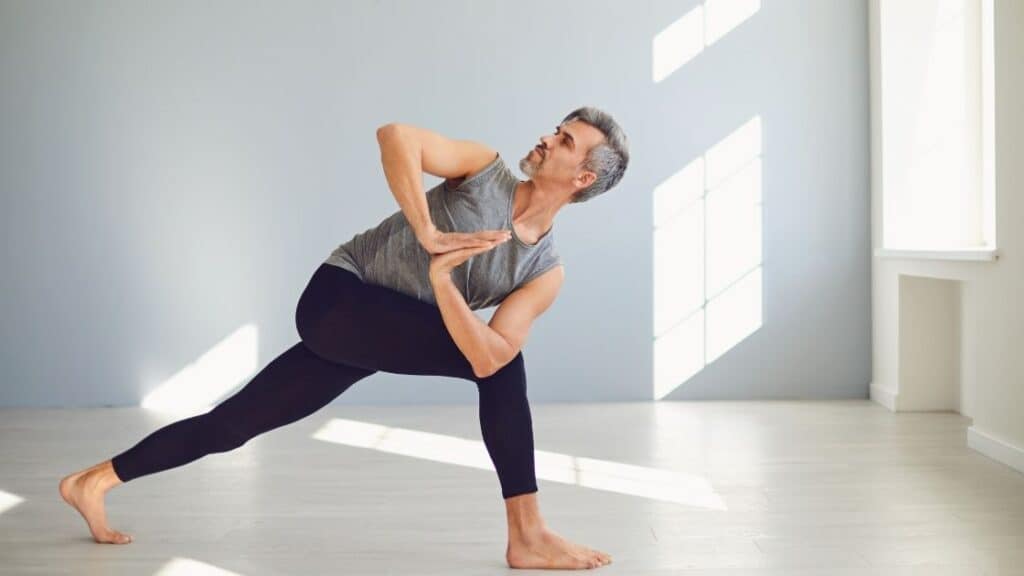
As we reach 40 and beyond, our strength and bone density start to diminish. This will generally lead to a decrease in running speed, aches, and pains in the days after a long run. The good news?
There are lots of things that we can do to keep our bodies healthy, in optimum shape, and avoiding this kind of age-related decline in running performance.
It’s important that, once we reach the age of 40, we start to focus on strength and take greater care of our joints. This is where yoga comes in. Yoga is the ideal activity to practice alongside regular running. It helps recovery, soothes muscle pain, and reduces the likelihood of injury.
So which yoga poses should runners over 40 be practicing? Well, that’s what we’re here to tell you about.
- PLANK POSE
- CHAIR POSE
- BOAT POSE
- WARRIOR II POSE
- BRIDGE POSE
- HALF SPLITS
- SEATED FORWARD FOLD
The benefits of practicing yoga for runners
Primarily, yoga helps us to strengthen the muscles that we rely on during running – namely the quads, hamstrings, hip flexors, and core. However, this is only true when practicing a style of yoga that focuses on strength.
If you prefer slower styles of yoga such as yin yoga and restorative yoga, although you’re not strengthening your body, know that you’re doing your nervous system a world of good by slowing down. When we take the time to slow down after running, we give our bodies time to recover as well as the space it needs to return to a calm state of breathing.
Things to keep in mind
When running and practicing yoga over 40, try to spend a little bit of time every day with a foam roller, using it to massage your calves, quads, and hamstrings. It also feels wonderful to stand up and roll a tennis ball underneath the soles of your feet – a massage that will benefit your entire leg!
When practicing yoga poses that involve bearing weight on your knees – such as cat-cow – it can be helpful to place a folded blanket underneath the knees to protect the joint.
As always, listen to your body! Overstretching in yoga poses can cause injuries that will prevent you from being able to run, so don’t overdo it. Listen to what your body needs, and learn to recognize the difference between discomfort and pain when practicing yoga.
(And in case you weren’t sure, discomfort is good, pain is bad).
The best yoga poses for runners over 40

(Poses that strengthen)
Plank Pose
Plank pose is one of the fastest ways to engage the core muscles, and you’re going to want these to be in top shape for both your performance and safety when running. It is also a great way to strengthen the shoulders and the muscles in the upper back.
Start from all fours, then step back with both feet so that your body is in a straight line all the way from your ankles to your shoulders.
Push into the hands to create a gentle rounding in the shoulders, almost as though you’re trying to push the floor away from you. Look between the hands to keep the neck in a neutral position and push your heels away from you whilst keeping the core engaged.
Stay here for 30-60 seconds, seeing if you can increase your hold time by a couple of seconds every day!

Chair Pose
Chair pose is the ultimate pose for waking up the quads and the glutes. And though you might hate us now, you’ll thank us later!
Start from standing with your feet either together or hip-distance apart – whichever you find most comfortable. From here, sink back as though you’re trying to sit on a chair, creating a deep bend in the knees and bringing the glutes towards the ground as you “hover” over the chair.
Keep the torso and chest lifted, then bring your arms overhead as though you’re holding a beach ball between your hands.
Stay here for 3-5 deep breaths before relaxing down into a forward fold – bringing your hands to the floor or a block as your neck and head hang heavy.

Boat Pose
The boat pose is an abdominal burner and, therefore, it’s great for helping to maintain strength in your running practice.
Start by sitting on your mat with your knees bent and your feet on the floor. Slowly start leaning back as you lift your feet off of the floor. Bring your shins to parallel with the ground. Make sure that your spine is long from your tailbone to the crown of your head. Bring your arms straight to reach alongside your calves.
Take 2-3 breaths.
From here, start to straighten the legs and lean further back as though you’re going to lay down. Keep your shoulders and legs lifted from the mat – so that only your glutes and lower back are touching the mat – finding a low boat pose. Take 2-3 breaths before moving back up into a high boat pose.
Repeat this 2-3 times, coming down to the floor between each round if you need to.

Warrior II Pose
Warrior II pose is a gentle way to open the hips and strengthen the lower body – it’s also a great boost for our self-confidence and self-esteem.
Start by standing at the front of your mat, then step back by about 1 meter with the left foot. Turn the left toes out to 90 degrees and take a deep bend in the front knee. From here, lift your arms out to either side of your torso so that they reach in opposite directions and gaze over the right fingertips.
Engage your core, stay strong through the left leg, and don’t let the right knee overhang the right ankle.
Stay here for 5-10 breaths before repeating on the other side.

Bridge Pose
The bridge pose strengthens the glutes whilst soothing the knees – especially with the use of a yoga block.
Start by laying on your back with your knees bent and your feet close enough that you can about touch your heels with your fingertips. Place a yoga block between your knees and your hands alongside you with palms facing down.
Take an inhale, and on an exhale, lift the hips towards the sky as you squeeze the glutes and the block between your knees. If you would like to take this pose further and open up the chest a little, interlace your fingers on the mat underneath you.
Stay here for 2-3 breaths before relaxing down. Repeat 2-3 times.

(Poses that stretch)
Half-Splits
Half-splits is an easy way to access a deep stretch in the hamstrings – perfect for a bit of post-run TLC.
Come into a low lunge by placing your hands on the floor and stepping back with your left foot. From here, drop the left knee to the ground, and start to sink your sit bones back towards your heel as you straighten through the front leg (coming onto the heel of your right foot).
You might like to place your hands on two yoga blocks to make this pose more comfortable!
Stay here for 1-2 minutes before repeating on the other side.
Note: If you have any pain behind the knee or in the glute of the front leg, ease out of the stretch a little bit.

Seated Forward Fold
The seated forward fold is another great stretch for tight hamstrings that also targets the lower back.
Start by sitting on your mat with your legs straight out in front of you and a blanket underneath your sit bones. (Lifting the pelvis slightly will help you to keep the spine straight).
If this is enough of a stretch for you, stay here!
Otherwise, fold at the hips – leading with the chest – to bring your tummy down towards your thighs. Only fold as far as you need to before feeling a lovely stretch in the hamstrings. If you have no pain in the lower back, feel free to round the shoulders and drop the head.
This pose may feel wonderful but a little too intense. If that’s the case, lift the knees slightly by bringing a rolled-up yoga mat or cushion underneath them.
Stay here for up to 5 minutes, moving deeper into the pose as your body invites you to.
The takeaway
Yoga is a runner’s best friend, especially if you’re over 40 and looking for a way to keep your body healthy whilst maintaining your running practice. Yoga is a great way to keep in contact with your body and recognize when a muscle or joint needs a little extra attention or recovery time.
Remember to focus on poses that strengthen the muscles needed for running and spend some time stretching the hamstrings post-run.
Protect the knees when you’re in any position that requires you to bear weight on the joint, and remember always to stay tuned in to what your body needs!


